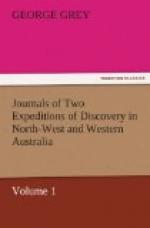The most remarkable geographical feature in North-Western Australia is a high range of mountains running north-north-east and south-south-west, named by me Stephen’s Range after James Stephen, Esquire, Under-Secretary of State for the Colonies. From this primary range several branches are thrown off: 1. One between Roe’s River on the north and Prince Regent’s River on the south. 2. Macdonald’s Range that throws off streams to Prince Regent’s River on the north and to Glenelg River on the south. 3. Whateley’s Range which gives forth streams to Glenelg River on the north, and to the low country behind Collier’s Bay and Dampier’s Land on the south.
These branch ranges as well as the principal one are all composed of ancient sandstone, deposited in nearly horizontal strata, or of basaltic rocks which are only visible in certain places, and are most fully developed in that part of Stephen’s Range which lies behind Collier’s Bay, and in the low ground near Glenelg River.
With the extent of Stephen’s Range I am unacquainted; but I have no doubt that the high land whence the Fitzroy River takes its rise is merely an under-feature again thrown off from it, and which I propose to call Wickham’s Range after Captain Wickham, R.N., the discoverer of the Fitzroy.
We may form some idea of the limits of Stephen’s Range in a north and east direction from the following passage extracted from Captain King’s survey of these coasts:*
Lacrosse Island is situated in the entrance of a deep opening trending to the south-south-west towards some steep, rugged hills. The character of the country is here entirely changed. Irregular ranges of detached rocky hills of sandstone formation, very slightly clothed with small shrubs and rising abruptly from extensive plains of low, level land, seem to have superseded the low wooded coasts that almost uninterruptedly prevails between this and Cape Wessel, a distance of more than six hundred miles!
(Footnote. King’s Australia volume 1 page 291.)
...
It appears therefore that this main range contains within it the sources of Roe’s River, Prince Regent’s and Glenelg Rivers, most probably the Fitzroy, and those that run into Cambridge Gulf and perhaps others that have their embouchures between this last and Admiralty Gulf.
From an accident having occurred to the only barometer we could carry with us I am unable to state the elevation of the highest land we reached above the level of the sea; but the appearance of the country on the coast does not give the impression of any very elevated ground existing near it. This however is owing to the great height of the shore cliffs and the gradual rise of the land towards the interior. The following observations, made with the barometer before it was broken, will show however that the altitude of the country at no great distance from the coast is considerable.
MACDONALD’S RANGE.




